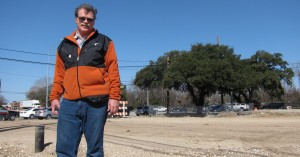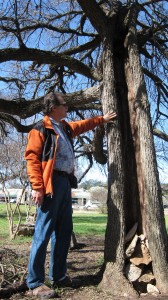Why It’s So Damn Hard to Move a Heritage Tree

Michael Fossum of the Austin Heritage Tree Foundation stands in front of the heritage Live Oak known as the "Taco Bell Tree." Fossum and his group fought to save the tree from being cut down for a traffic project. Now it's going to be moved across the street.
Back in the 1970s and ’80s, it probably looked like something out of Dazed and Confused. Teenagers pulling up in T-Birds, wind in their hair, to hang out in the parking lot of a Taco Bell. The sun would set in the Hill Country to the west, sending a glow through the branches of an old Live Oak tree. Today the Taco Bell and the teenagers are long gone, but the tree remains, affectionately known as the “Taco Bell Tree.”
It’s also now at an intersection best known for being a traffic nightmare – the Y at Oak Hill – where two highways intersect and a third road feeds into the jumble. In order to improve that intersection, the state embarked on a temporary plan to expand it that would help for the next five years, while something longer term is put into place. The plan included cutting down the Taco Bell Tree, which has been here long before drive-thrus (or even combustion engines). All right, all right, all right.
Texas trees have to be hardy. There are Live Oaks along the Gulf Coast that survived Hurricane Katrina while buildings around them toppled; those trees probably survived other storms long before that. But as the Lone Star State grows, it needs more roads. More homes. More developments. The big trees are now coming into conflict with a state that can’t help keep getting bigger. And the trees can either be cut down, built around, or, as in the case of the Taco Bell Tree, they can be moved. At a hefty price.
To understand why it’s such an expensive and difficult process to move a heritage tree, it helps to talk to Michael Fossum, who heads the Austin Heritage Tree Foundation. That group has led the effort to save the Taco Bell Tree and other heritage trees in Central Texas. (While Austin has a heritage tree ordinance to protect trees like this one, it doesn’t supersede the authority of TxDOT to cut them down.)
“You can see that it has a very thick, robust canopy,” Fossum says, pointing to the large Live Oak. The diameter at its base is around 35 inches. “So we see a nice green, large canopy – it’s about fifty feet in diameter, about thirty feet tall. Just a great specimen of a Central Texas Live Oak.”

Photo by Terrence Henry/StateImpact Texas
Michael Fossum of the Austin Heritage Tree Foundation points out a Cedar Elm that has been hollowed out by lightning. It's still alive. "This is a good example of what survivors trees are," Fossum says.
Fossum’s group convinced TxDOT to give them time to raise money to move the tree. They came up with $20,000, while the City of Austin put together the rest, around $90,000. All to move one tree across the street – about one stoplight and fifty yards away – where it will join others in a grove along Williamson Creek. Why such a steep price tag?
For that fifty feet of the Taco Bell Tree’s canopy, there’s an even bigger root system below we can’t see. In a way, trees are like icebergs. There’s a lot more going on underneath the ground than you realize. The ratio can be as high as 12:1 for the roots to the canopy. In this case, that means that for 50 feet of canopy, you’re accounting for 600 feet of roots. And that root system is the most delicate part of the process.
“For a tree to survive and thrive, you’ve got to have enough roots to support the tree. And that’s the key aspect of doing this,” says Mark Merit, with Environmental Design, a company that specializes in moving trees. They’ve been at it for nearly forty years, moving trees for the 9/11 memorial, on the Pebble Beach golf course, even a tree at Lance Armstrong’s old house. (The price tag for that cosmetic project? Reportedly $200,000.) And yes, Environmental Design got the contract to move the Taco Bell Tree.
Merit points out that the idea of moving a tree so it can continue to grow is nothing new. We know it at least goes back to Egyptian times, when the Pharaoh Hatshepsut had a few dozen Myrrh trees (used for perfume) moved from the land of Punt to her temple in Egypt. The trees were carefully transplanted by digging around their root system and moving them with their native soil. Once transplanted, they thrived, and the act of tree transplanting was born.
Tree transplanting has continued through the ages, Merit says. There are trees that were moved in the 1800s in Great Britain that were already a thousand years old. Many of them are still alive today.
It’s much cheaper and easier to cut down a heritage tree in the face of development. A TxDOT construction worker at the intersection project who would only give his first name, Jimmy, told me that if the trees are removed, “we don’t have to be so careful of our digging, breaking limbs. But if we can save them, we save a lot of trees. We’d like to save more if we could.”
And if you’re going to build around them, it has to be done carefully. “The way we’re developing our area now, there’s less and less room for these big trees,” Fossum says. “They need a certain amount of soil volume.” Several Live Oaks in the small town of Snook, Texas that are hundreds of years old were spared from the axe of TxDOT after a public outcry. The agency simply moved the road a bit, and will have the heritage trees become part of the median.
But sometimes the only option left is to move a tree. And if you are going to move a heritage tree, you need to start with those extensive roots. The tree is trenched around, the root system mapped out, and the ends of some of the roots pruned to signal to them that they’re going to need to start growing out again. The roots are gathered and wrapped up, creating the “root ball.”
“Then there should be a time period where you add soil amendments and water the roots in order to stimulate root growth, so you have a healthy root ball,” Fossum says.
Step two is cutting the soil underneath the tree and getting a flat platform underneath there. That will protect the root system when it gets moved.
“Somebody described it once like you’re trying to pick up a wedding cake with your hands,” Merit says. “You’re gonna make a mess out of it. So with a structural platform it’s like putting a plate underneath it. And now you just lift on the plate and it works fine.”
This is where things can get really expensive. That’s because in addition to the weight of the tree and its roots, you’ve got the weight of all that dirt encasing the roots coming along for the ride. That soil mass can weigh as much as ten times as much as the actual tree. In all, for a large tree like this, the weight could be almost 400,000 pounds.
Here’s a way of picturing it: that’s as much weight as two dozen adult African elephants. Being moved with one crane. For the Taco Bell Tree, that alone will take five days. They’ll have to close the road at night.
Then at the new site across the road, a large hole will be dug and the tree carefully placed inside. The root ball will be uncovered, and the tree will be watched – and most importantly, watered – over the next five years.
“Moisture. That’s absolutely the number one thing,” says Merit with Environmental Design. “Not enough is bad. Too much is probably even worse.” When done correctly, Merit says, transplanting trees has a pretty high success rate, around 95 percent.
And once the five-year mark has passed? Well, it’s hopefully back to normal for the Taco Bell Tree. “It should live for hundreds of years,” Fossum says.
The Taco Bell Tree should start the moving process in the next few weeks. Once it’s started, it should be in its new home within a month.